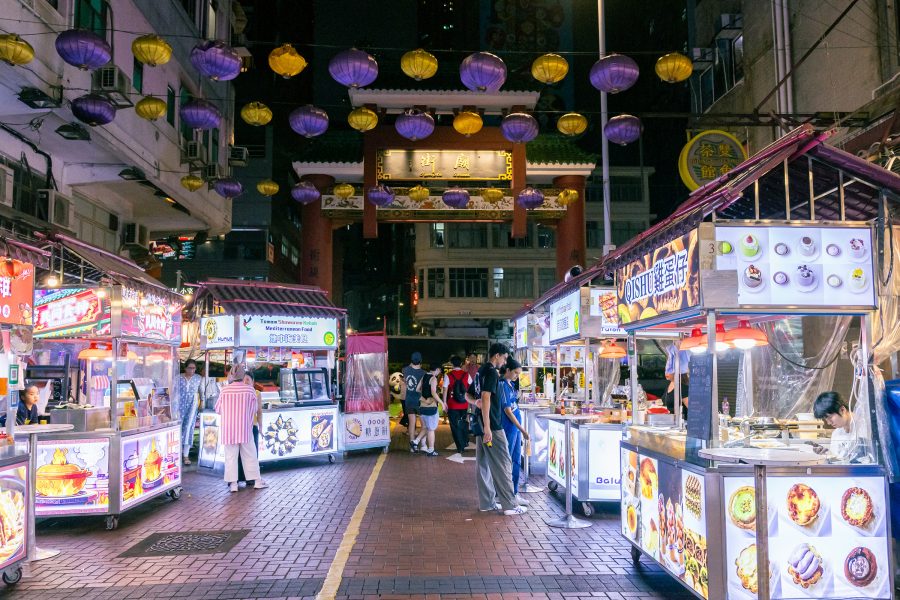Hong Kong street food: a short history of its iconic hawkers

People in Hong Kong will tell you that autumn isn’t what it used to be. They remember wearing jumpers at Mid-Autumn Festival; yet today, the weather decrees that they dress in shorts and t-shirts. But even if the summer heat lingers longer, there’s one sign of autumn that never changes: the aroma of charcoal.
It starts around early October, wafting through the streets up to open windows. It never takes long to find the source. Every year, for the six months the muggy heat subsides, itinerant hawkers roast sweet potatoes, chestnuts and quail eggs over charcoal, selling them in paper bags that are eagerly ripped open by schoolchildren and office workers alike.
Credit: South China Morning Post/Getty Images
Credit: GmbH/Getty Images
The charcoal roasters used to have plenty of company. Fishballs, pork intestines, fried tofu, gai dan zai (“little chicken egg” waffles), crunchy dragon’s beard candy made from pulled sugar and peanuts – they were all treats you could find on the streets of our home city.
As long as Hong Kong has had streets, people have been selling food in them. In its early days, men and women walked up and down the city’s narrow, hilly lanes hawking seasonal vegetables, salted fish and freshly butchered meat. They advertised their goods by calling out in a sing-song melody – “at least one million cries uttered every day,” according to Reverend J Nacken, a British missionary who described the scene in an 1873 letter.
Nacken also observed that while Hong Kongers tended to be early risers, “the congee hawker has been up an hour or two before sunrise.” He described how hawkers carried their rice porridge in two boxes hanging from a bamboo pole over their shoulders, each containing a pot heated by a small charcoal fire. “You may have pig’s blood congee, fish congee, mulberry root flavoured congee, or barley, or kidney or pork and a variety of other congees.”
Credit: South China Morning Post/Getty Images
Credit: NurPhoto/Getty Images
These mobile hawkers were joined by little green huts known as dai pai dong in the 1950s. Hundreds of them lined the streets near the wharves and factories that drove the city’s booming economy. These were the places that pioneered the satisfying, high-calorie “soy sauce” Chinese-Western dishes that are now a Hong Kong favourite. For many locals, nothing starts the day off quite like a milk tea with a ham and macaroni soup, or maybe a chunky fried Spam sandwich.
By the 1970s, more than 50,000 hawkers thronged the city’s streets, and the government decided that regulations were needed. It began to license the hawkers and assign them permanent places to ply their trade. The catch was that their licences couldn’t be transferred. Eventually, the entire hawking trade was expected to die out.
For food hawkers, that happened sooner rather than later. Except for the charcoal-burning sweet potato vendors, and a handful of dai pai dongs, no hawkers are permitted to sell food on the streets of Hong Kong. If you want to sell braised duck liver or stinky tofu, you’ll need to rent a shop space. More recently, the government has gone to considerable lengths to revitalise Hong Kong’s night markets, especially around Temple Street.
Credit: South China Morning Post/Getty Images
But the city also prides itself on its entrepreneurial spirit, and for years a call of “dou fu fa, dou fu fa!” rang through Yau Yat Chuen in the middle of Kowloon as an old man rode his bicycle around the neighbourhood, selling sweet tofu pudding from a wooden bucket. Every Chinese New Year, the streets were filled with the scent of grilled oysters and curry fishballs as night markets sprang up around Hong Kong.
The old man hasn’t been around for a while. But at least you can still count on the dry autumn breeze to carry that mouthwatering scent of charcoal.
This story was originally published in October 2018 and updated in August 2025.
More inspiration
Hong Kong travel information
- China – the Chinese Mainland, Hong Kong SAR, Macao SAR and Taiwan Region
- Hong Kong SAR - English
- Chinese Mainland (China) - English
- Taiwan, China - English
- 香港特別行政區 - 繁體中文
- 中国內地 - 简体中文
- 中國台灣 - 繁體中文
- Africa
- South Africa - English
- Asia
- Bangladesh - English
- Korea - English
- Singapore - English
- Cambodia - English
- 한국 - 한국어
- Sri Lanka - English
- India - English
- Malaysia - English
- Thailand - English
- Indonesia - English
- Maldives - English
- ประเทศไทย - ภาษาไทย
- Indonesia - Bahasa Indonesia
- Myanmar - English
- Vietnam - English
- Japan - English
- Nepal - English
- Việt Nam - tiếng Việt
- 日本 - 日本語
- Philippines - English
- Australasia
- Australia - English
- New Zealand - English